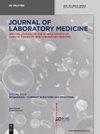The lncRNA prostate androgen-regulated transcript 1 (PART-1) promotes non-small cell lung cancer progression by regulating the miR-204-3p/IGFBP-2 pathway
IF 1.1
4区 医学
Q4 MEDICAL LABORATORY TECHNOLOGY
引用次数: 0
Abstract
Abstract Objectives Lung cancer is a common malignant tumour of the lung and the leading cause of cancer mortality worldwide. Non-small cell lung cancer (NSCLC) accounts for 80–85% of lung cancers, and 40% of NSCLCs have spread beyond the lungs by the time they are diagnosed. The long noncoding RNA (lncRNA) prostate androgen-regulated transcript 1 (PART-1) has been reported to promote the development of several cancers. Methods In the current study, we investigated the role of PART-1 in the proliferation, invasion, and migration of NSCLC. Results The expression levels of the PART-1 gene were higher in NSCLC cell lines, including A549, H1229, H1650, H1975, and PC9, than in human bronchial epithelia (HBE) cell lines. Knocking down PART-1 inhibited the proliferation, invasion, and migration of A549 cells and decreased tumour proliferation in nude mice. We confirmed that PART-1 targeted miR-204-3p directly and that miR-204-3p targeted insulin-like growth factor binding protein 2 (IGFBP-2) directly. Furthermore, we discovered that PART-1 impacts NSCLC progression by regulating the miR-204-3p-targeted IGFBP-2 pathway. Conclusions The lncRNA PART-1 might be a target for treating NSCLC and an early marker in the diagnosis of early lung cancer.lncRNA前列腺雄激素调节转录物1(PART-1)通过调节miR-204-3p/IGFBP-2途径促进非小细胞肺癌癌症进展
肺癌是一种常见的肺部恶性肿瘤,是世界范围内癌症死亡的主要原因。非小细胞肺癌(NSCLC)占肺癌的80-85%,其中40%的非小细胞肺癌在确诊时已经扩散到肺外。据报道,长链非编码RNA (lncRNA)前列腺雄激素调节转录物1 (PART-1)可促进多种癌症的发展。方法本研究探讨PART-1在非小细胞肺癌的增殖、侵袭和迁移中的作用。结果PART-1基因在A549、H1229、H1650、H1975、PC9等非小细胞肺癌细胞株中的表达水平高于人支气管上皮(HBE)细胞株。敲除PART-1可抑制A549细胞的增殖、侵袭和迁移,降低裸鼠肿瘤的增殖。我们证实PART-1直接靶向miR-204-3p, miR-204-3p直接靶向胰岛素样生长因子结合蛋白2 (IGFBP-2)。此外,我们发现part1通过调节mir -204-3p靶向的IGFBP-2途径影响NSCLC的进展。结论lncRNA PART-1可能是治疗非小细胞肺癌的靶点,也是早期肺癌诊断的早期标志物。
本文章由计算机程序翻译,如有差异,请以英文原文为准。
求助全文
约1分钟内获得全文
求助全文
来源期刊

Journal of Laboratory Medicine
Mathematics-Discrete Mathematics and Combinatorics
CiteScore
2.50
自引率
0.00%
发文量
39
审稿时长
10 weeks
期刊介绍:
The Journal of Laboratory Medicine (JLM) is a bi-monthly published journal that reports on the latest developments in laboratory medicine. Particular focus is placed on the diagnostic aspects of the clinical laboratory, although technical, regulatory, and educational topics are equally covered. The Journal specializes in the publication of high-standard, competent and timely review articles on clinical, methodological and pathogenic aspects of modern laboratory diagnostics. These reviews are critically reviewed by expert reviewers and JLM’s Associate Editors who are specialists in the various subdisciplines of laboratory medicine. In addition, JLM publishes original research articles, case reports, point/counterpoint articles and letters to the editor, all of which are peer reviewed by at least two experts in the field.
 求助内容:
求助内容: 应助结果提醒方式:
应助结果提醒方式:


